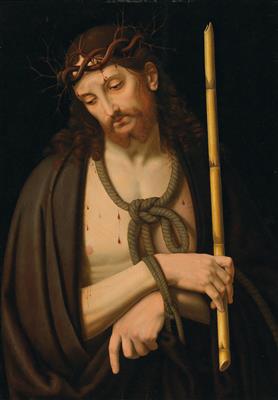Studio of Andrea Solario

(Milan circa 1465–1524)
Ecce Homo,
tempera and oil on panel, 66 x 46.5 cm, framed
Provenance:
with Pavia, Milan (according to Longhi);
Private collection, Italy
The painting is recorded in the Fototeca Longhi (photograph no. 520253) as Andrea Solario.
The present painting relates to a composition by Andrea Solario of which more than one autograph version is known. David Alan Brown has identified the paintings conserved in the John G. Johnson Collection of the Philadelphia Museum of Art (inv. J 274), signed, and another in the Museum der Bildenden Künst, Leipzig (inv. 1660), signed, as full autograph works. These paintings are both datable to circa 1507-1509 and were therefore executed during the artist’s French sojourn (see D. A. Brown, Andrea Solario, Milan 1987, pp. 212-214, no.50 and no.51).
The present work is painted on an oak panel, and it may be possible to also date it to the period of Solario´s French sojourn. The structure of the panel also reveals an Italian method of construction as it is composed of another hard wood in the chestnut cross bars, which have been cut in trapezoidal form. The use of oak panels as a support appears to be significantly recurrent in Solario’s work, and as such was not unusual. The previously mentioned Ecce Homo in Philadelphia was also painted on oak.
Following the political and military struggles that saw power in Milan pass to the French. Andrea Solario obtained good commissions from the new leadership, and this culminated when he moved to France in the service of Cardinal Georges I d’Amboise where he was engaged in the mural decoration of the castle in Gaillon.
The present Ecce Homo shows Christ with his head bent in resignation, and his body marked by the beatings of the flagellation. It combines an emotive force and naturalism of Flemish origin, with a new dramatic language introduced to Milan by Leonardo da Vinci. The present powerful representation enjoyed great success, to the extent that it was repeated by other Lombard studios: not only by Simon Mailly, called Simone de Châlons, a late follower of the artist, but also by the ateliers of Bernardino Luini (Wallref-Richartz Museum, Cologne) and by Giampietrino (Musée Magnin, Dijon). There must therefore have been a graphic modello, or cartoon, that was surely used in this period and for some years later.
These considerations, in combination with an examination of the present work’s pictorial quality, could lead one to believe that the work was jointly executed by Solario and his studio, and that is should be dated to between 1510 and 1520.
We are grateful to Andrea G. De Marchi for his help in cataloguing the present painting.
17.10.2017 - 18:00
- Estimate:
-
EUR 80,000.- to EUR 120,000.-
Studio of Andrea Solario
(Milan circa 1465–1524)
Ecce Homo,
tempera and oil on panel, 66 x 46.5 cm, framed
Provenance:
with Pavia, Milan (according to Longhi);
Private collection, Italy
The painting is recorded in the Fototeca Longhi (photograph no. 520253) as Andrea Solario.
The present painting relates to a composition by Andrea Solario of which more than one autograph version is known. David Alan Brown has identified the paintings conserved in the John G. Johnson Collection of the Philadelphia Museum of Art (inv. J 274), signed, and another in the Museum der Bildenden Künst, Leipzig (inv. 1660), signed, as full autograph works. These paintings are both datable to circa 1507-1509 and were therefore executed during the artist’s French sojourn (see D. A. Brown, Andrea Solario, Milan 1987, pp. 212-214, no.50 and no.51).
The present work is painted on an oak panel, and it may be possible to also date it to the period of Solario´s French sojourn. The structure of the panel also reveals an Italian method of construction as it is composed of another hard wood in the chestnut cross bars, which have been cut in trapezoidal form. The use of oak panels as a support appears to be significantly recurrent in Solario’s work, and as such was not unusual. The previously mentioned Ecce Homo in Philadelphia was also painted on oak.
Following the political and military struggles that saw power in Milan pass to the French. Andrea Solario obtained good commissions from the new leadership, and this culminated when he moved to France in the service of Cardinal Georges I d’Amboise where he was engaged in the mural decoration of the castle in Gaillon.
The present Ecce Homo shows Christ with his head bent in resignation, and his body marked by the beatings of the flagellation. It combines an emotive force and naturalism of Flemish origin, with a new dramatic language introduced to Milan by Leonardo da Vinci. The present powerful representation enjoyed great success, to the extent that it was repeated by other Lombard studios: not only by Simon Mailly, called Simone de Châlons, a late follower of the artist, but also by the ateliers of Bernardino Luini (Wallref-Richartz Museum, Cologne) and by Giampietrino (Musée Magnin, Dijon). There must therefore have been a graphic modello, or cartoon, that was surely used in this period and for some years later.
These considerations, in combination with an examination of the present work’s pictorial quality, could lead one to believe that the work was jointly executed by Solario and his studio, and that is should be dated to between 1510 and 1520.
We are grateful to Andrea G. De Marchi for his help in cataloguing the present painting.
|
Buyers hotline
Mon.-Fri.: 10.00am - 5.00pm
old.masters@dorotheum.at +43 1 515 60 403 |
| Auction: | Old Master Paintings |
| Auction type: | Saleroom auction |
| Date: | 17.10.2017 - 18:00 |
| Location: | Vienna | Palais Dorotheum |
| Exhibition: | 07.10. - 17.10.2017 |
